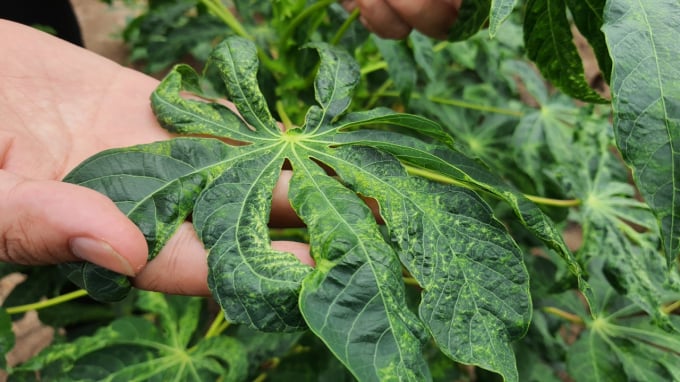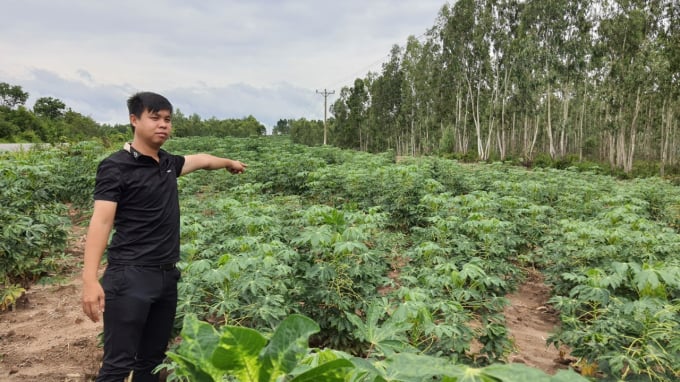November 27, 2025 | 16:09 GMT +7
November 27, 2025 | 16:09 GMT +7
Hotline: 0913.378.918
November 27, 2025 | 16:09 GMT +7
Hotline: 0913.378.918

Cassava mosaic disease is breaking out in the North Central Highlands. Photo: Tuan Anh.
According to the Sub-Department of Cultivation and Plant Protection in Gia Lai, in the recent three years, the CMD has continuously damaged almost the area of cassava cultivation in northern and south-northern districts of the province. By June 23, it spread to an area of 1,000 ha, concentrating in some districts of An Khe, Ia Pa, Krong Pa. The disease is categorized as dangerous with the possibility of spreading quickly and difficult to prevent.
The disease will reduce the amount of starch accumulated in cassava tubers leading to the reduction in selling price, directly affecting farmers’ income.
Dinh Xuan Duyen, Head of the Department of Agriculture and Rural Development of Krong Pa district said that there is more than 20,000 ha of cassava in the district, and cassava areas in all communes are affected by CMD posing risks of spreading quickly. In Chu Ngoc commune alone, there are more than 1,300 hectares of cassava growing, with 50% of them suffering from the disease.
The main reason leading to mosaic disease in cassava was due to old varieties. Duyen said that to overcome the CMD, farmers should switch to other crops for a while and then return to cassava planting. Instead of picking the old varieties, people should choose the KM94 variety, which is resistant to the disease.
According to the instruction of the subdepartment, farmers should zone the area with powdery mildew to spray insecticides to prevent the spread of disease to the off-season cassava area. For the main-crop cassava area, it is necessary to spray powdery mildew before uprooting, collecting, and destroying all cassava plants in the field for heavily infected areas.
Farmers need to avoid HL-S11 cassava variety as well as examine to ensure disease-free origin. Besides, localities should encourage farmers to shift the infected area to another crop for one year to cut off the disease source before re-planting cassava.

Thousands of hectares of cassava growing area of people suffer from leaf mosaic disease. Photo: Tuan Anh.
In Kon Tum, there is an increasing area infected with CMD, prompting the provincial agricultural sector to urgently implement measures to prevent.
As of July 7, the province had 363ha of cassava infected with leaf mosaic disease. The city of Kon Tum is the locality with the most infected cassava area with over 315ha and the disease affects the off-season cassava area (planted in September 2020, harvested in September 2021).
Authority of the Sub-Department of Cultivation and Plant Protection of Kon Tum province said that in previous years, cassava mosaic disease only occurred in a small area and did not form serious outbreak as today.
Mentioning the cause, the authority said that it was due to the unknown origin of cassava bought from markets or planted from the variety with the existed disease. In addition, due to the unusual weather this year, in June there were prolonged droughts that created favorable conditions for powdery mildew to thrive, creating conditions for leaf mosaic virus to be transmitted from sick to healthier plants.
Regarding the remedy, the local agricultural leader said that for the off-season cassava area, the province has directed localities to zone and spraying insecticides against powdery mildew, limiting the spread of disease. At the same time, people need to harvest early to make full use of tubers and destroy all remnants of infected plants.
For the main-crop cassava area, it is necessary to spray powdery mildew insecticide before uprooting and destroying the heavily infected areas and the plants in the light and medium infected areas. At the same time, it instructed households to swift to suitable crops on infected cassava areas, not to reuse infected varieties for the next crop.

(VAN) On the morning of November 27 in Beijing, Minister Tran Duc Thang and the Deputy Commissioner General of the General Administration of Customs of China signed a protocol on fresh jackfruit exports.

(VAN) As floodwaters recede, a vast network of irrigation works across eastern Gia Lai is emerging in a state of severe disrepair, with extensive damage demanding urgent restoration ahead of the 2025-2026 winter-spring cropping season.

(VAN) The conference reviewing three years of implementing Decision 911 identified the need to prioritize improving marine environmental quality and promoting sustainable fisheries development.

(VAN) Le Hoai Trung, Member of the Communist Party of Viet Nam Central Committee and Minister of Foreign Affairs, held talks with Vi Thao, Chairman of the Guangxi Zhuang Autonomous Region (China) this week.

(VAN) The Mekong River Commission adopts the 2026 - 2030 Strategic Plan with a people-centered approach.
/2025/11/26/1720-1-200855_132.jpg)
(VAN) Viet Nam and Japan have many conditions to expand cooperation on climate change adaptation, particularly in disaster risk management based on advanced technologies.

(VAN) The strong development of digital technology and artificial intelligence is opening up opportunities to transform science and technology into a 'Magic eye' for disaster forecasting and early warning.